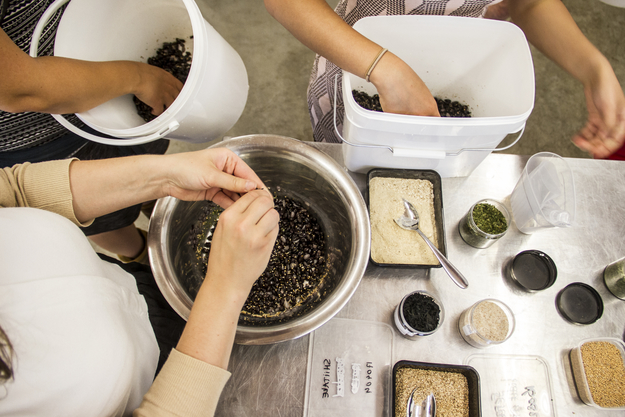Mycelium as a delicious meat substitute
It is said that mycelium has the potential to replace all kinds of harmful materials such as plastics and batteries. At Mediamatic, we are interested in the cultural, artistic and culinary applications of mycelium. Another way in which mycelium could benefit the environment is by replacing meat in people’s diets, as meat production causes lots of pollution and is bad for the climate because of high carbon dioxide emissions. But regardless of its environmental and health benefits, the fact that tempeh can be very tasty is already a very good reason to include it in your menu!
Learn and grow
During this workshop you will learn all about the symbiosis between the mushroom and beans and the underlying microbiological process. Under the guidance of Sasker Scheerder you will prepare your own beans. You will gain a better understanding of preparing tempeh yourself using any legume you like. Two days after the workshop, the beans will have turned into tempeh and you can collect your self-made tempeh at Mediamatic!
Also we'll show you how to grow tempeh in molds to make Tempeh shapes. Mediamatic is developing edible table ware this way and we'll gladly share our kwowledge in this workshop.
About Sasker Scheerder
Sasker Scheerder is the head of Manenwolf’s rokerij and foodlab. He uses all kinds of natural processes for making foods, such as smoking, drying, salting, fermenting, infuse, brooding and pickle. Often, these are ancient techniques for food preparation but Sasker uses them to create exciting new foods, trying to defy bad taste and loveless foods. During his tempeh workshop, he makes tempeh out of a wide variety of organic beans.
Tempeh Ware team
Mediamatic is growing tempeh in shapes to make our own edible table ware that eliminates waste in a tasteful and healthy way. The current team constists of Corinne Mulder and Iris van Hulst and is lead by Willem Velthoven.
Bio Clean Lab
Both the introduction and the preparation of the tempeh will take place in the Bio Clean Lab; our laboratory which is equipped for working with micro-organisms. The Clean Lab is not only available for individual artists and artist in residency programs but is also the homebase for our own Myco Insulation Brewery, a permanent exhibition and production line where we produce beer and grow mycelium insulation panels on the spent grains of the brewing process.
Info
Workshop: Tempeh
Friday 28 April, 14:45 - 17:00
Mediamatic Biotoop, Dijksgracht 6, Amsterdam
Tickets: Regular €40,- / Student €28,- (excl. Administration fee)










